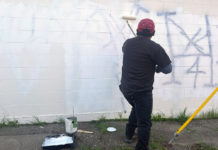
Former Stumptown first named Guerneville in 1870 with first post office
The loggers and early settlers who lived, logged and labored in the mid-1800’s at the “big bottom” where Fife Creek empties into the Russian River, probably never thought about what kind of legacy or beginnings to a local history they were shaping with their basic frontier lives. But it’s been 150 years since a U.S. post office was established here in 1870 and the name of the place Guerneville has more chapters of history than can be remembered.
Plans this month to share as many historical mileposts, evolving eras, famous names, photo displays and oral histories all have been canceled due to the coronavirus pandemic shutdown. Commerative banners have been hung downtown by the Russian River Historical Society to mark the official dates of the town’s sesquicentennial. Some historic photos are being displayed at the Guerneville post office and at the Guerneville Bank Club on Main Street.
Most people know that Guerneville was first known as Stumptown because of all the redwood logging activity along the river and the flat alluvial basin along Fife Creek. George Guerne built a sawmill and assisted local business owner John Washington Bagley to acquire a post office. It was Bagley’s idea to name the town and post office after Guerne. Other prominent mill operators were Murphy and Heald (as in Healdsburg.) Nearby, the Korbel brothers planted grape vineyards and led the effort to bring a railroad through the settlement. By 1877, Guerneville was connected to San Francisco via the San Francisco and North Pacific Railroad and the San Francisco Bay ferries at Sausalito.
Other sesquicentennial activities were to include a Stumptown Parade, a community ice cream social, history programs at Guerneville School and a gala costume ball, originally scheduled for July 25. Russian River Historical Society board president Jane Berry expressed disappointment that all the volunteers and committee work was dashed by the virus. The society did publish a special edition of their newsletter, “Yesterday & Yesteryear.” The 20-page publication includes brief articles and photos of the town’s bridges, churches, doctors, earthquakes, schools, law enforcement, fires, historical women and notable businesses.
Guerneville’s history is a story about the river, redwoods, floods, a lively main street of bars, ballrooms and eateries and succeeding eras of vacationers, summer attractions, hippie and biker invasions, a “gay renaissance” and more recent years of converting hundreds of summer cabins to year-round residences. Guerneville and surrounding communities are now home to 4,500 people.
Local historian and writer John Schubert has chronicled Guerneville’s history and notable people with several books, articles and oral recordings. He currently serves as vice president of the historical society.
His books are available for sale at the historical society website (www.russianriverhisotry.org) and are also available through the Sonoma County Library (sonomalibrary.org).
Titles include, “Guerneville Early Days, A History of the Lower Russian River,” “Hidden History of Sonoma County,” “Russian River, Then and Now.” “Tales of the Russian River – Stumptown Stories” and others.
Another fun and informative read is the recently published book by retired pastor and newspaper columnist Robert “Bob” Jones. “Proud to be a River Rat,” profiles dozens of the town’s historical, memorable and colorful people. The book is available on Amazon, the Guerneville 5&10, Northwood Golf Course and Copperfield’s Books.
One prominent historical structure is the green-painted steel truss bridge that crosses the river at the center of town. It was built in 1922 and was destined for demolition by CalTrans in 1989 when a new concrete crossing was planned. A citizen’s group sued the state agency and won National Historical Landmark status for the bridge in 1998. The bridge is now open to pedestrians and cyclists.
Guerneville’s reputation as a “rough and rowdy” place didn’t end with the demise of all its commercial redwood and giant fir logging days. As a favorite summer retreat for visitors from San Francisco and other places, waves of fun-seeking families and revelers added to the lower Russian River’s raucous and easy-going character. The word bohemian is carved on many of the area’s landmarks and milestones. The area still hosts an annual western rodeo each summer and the small town hosts two annual parades, a Stumptown Parade and a Gay Pride Parade.
In 1978, Peter Pender came to Guerneville from Philadelphia, by way of San Francisco. He purchased the historical Murphy’s Resort and renamed as Fife’s and made it Guerneville’s first “gay friendly” resort. Thousands of gay men discovered the freedom and relaxation under the giant redwoods along the cool Russian River. Many other gay-oriented businesses followed and a “Gay Renaissance” was proclaimed for the former logging town. Soon, The Willows, The Highlands, Paradise Cove, The Woods, the River Village, and the Russian River Resort would open, along with Rainbow Cattle Club bar on Main Street.
Pender died in 1990 of HIV/AIDS, one of several thousand locals to die during the AIDS epidemic. (Fife’s is now the Dawn Ranch.)
Few towns in California or beyond have suffered so much destruction from fires, floods and earthquakes. The entire town was lost to an arsonist in 1884. Ten years later another fire swept through the settlement, leaving only two structures standing. Historical fire “victims” included over the years the Hocker & Cannon Hardware Store, Nickolls Hotel, Buck’s Ranch, and the Guerneville Inn.
Although all the town’s sesquicentennial events have been canceled, Guerneville and the lower Russian River is enjoying a very busy summer, even as the county and most of California remains under strict COVID-19 pandemic public health restrictions. It turns out there’s a lot of enjoyment, recreation and socially-distanced visiting you can do under the redwood trees, on the river’s many pocket beaches and up and down Guerneville’s Main Street with outdoor eating, fresh air art displays and lots of rural relaxation from the more urban pace of shelter-in-place living.







